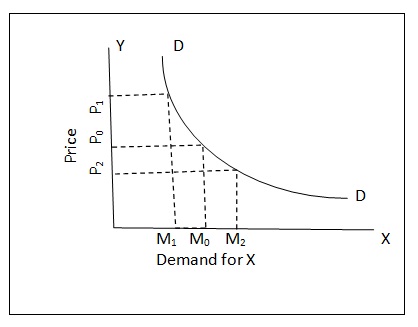The price of a given commodity is an important factor influencing its demand. If the price is very high, only a few rich persons can afford to buy it. Hence, the quantity of the commodity bought at this high price will be low, i.e. the commodity will have a lower demand. On the other hand, if the price is low, it will be within the reach of a large number of people to buy it, consequently a greater quantity of the commodity will be bought and the demand shall be high. Thus, the prevailing price for a commodity or service is an important determinant of the level of its demand.
The effect of changes in the price of a commodity on its demand is in the reverse direction. When the price of a good X goes up, the quantity demanded falls. Similarly, when the price of X goes down, the quantity demanded increases. This tendency of the demand for a goods to change in the inverse direction to a change in price.
The price of X is measured on the Y – axis whereas the quantity demanded on the X – axis. When the price of X is OP0 , the quantity demanded is OM1. Similarly, when there is a fall in the price of X to OP2, the quantity demanded increases to OM2. Thus, other things being equal, the quantity demanded of a given commodity is likely to bring about a change in its demand.
